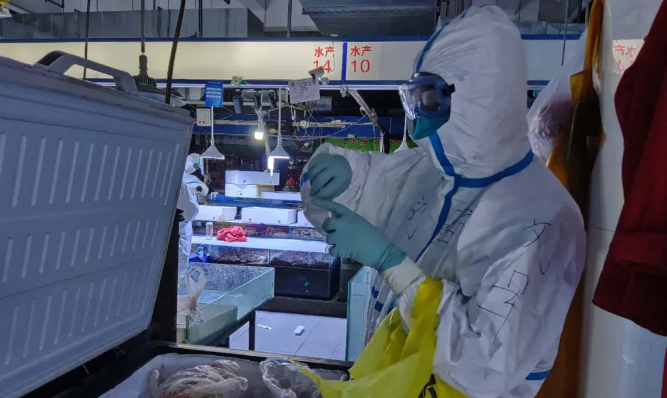
Scientists collect samples at the Xinfadi wholesale market. /The Beijing News
The Universe Tribune / ID/20 06 2020/TUT/00103
The coronavirus from a new local cluster in the Chinese capital is closely related to the European strain, an official from the World Health Organization said on Friday.
“As we understand it, the virus is closely related to the European strain,” Maria Van Kerkhove, WHO’s technical lead on COVID-19 said.
It came after Beijing released and shared the gene sequence data of the COVID-19 virus from the Xinfadi market infection cluster on Thursday.
In light of the recent COVID-19 cluster outbreaks in China, a senior World Health Organization (WHO) expert commended Beijing for its efforts to control its spread.
Dr. Michael Ryan, executive director of the Health Emergencies Program of the WHO, made the remark at a press conference in Geneva on Friday.
Illustrating the good examples of Germany, Japan and South Korea, Ryan said: “I think our colleagues in Beijing as well are mounting a very large-scale response… in an attempt to prevent that from getting out of hand,” underscoring the importance of rapid detection, investigation and suppression of cluster cases.
“You get a few cases occurring and it then a super spreading event or something happening where there’s a large amplification of the disease. And when that happens, you want to avoid that first amplification turning back into community transmission,” he noted.
Ryan noted that it has become difficult to discern whether the rise in COVID-19 cases in many countries has been due to increased testing or the result of further spreading.
“It’s very important at that time to look at things like hospitalizations and deaths. If you start to see hospitalizations going up, that’s not because of testing; if you start to see the number of people dying going up unexpectedly, that’s not because of testing,” he emphasized.
“What we really want to see is that the ability to use data, to use investigation, to use testing, to use physical and social measures in an agile, adaptive, sensitive way where you’re doing the absolute minimum you need to do to suppress the infection or the maximum you need to do with the minimum disruption of society,” he added.
Before it, On China released the gene sequence data of the COVID-19 virus from Beijing’s Xinfadi market infection cluster on Thursday, according to the Chinese Center for Disease Control and Prevention (CDC).
The Chinese CDC also submitted the genome sequencing data for the virus to the World Health Organization (WHO).
The information published on the website of state-backed National Microbiology Data Center on Friday shows the data is from two confirmed patients and one local environmental sample.
Zhang Yong, assistant director of the Institute of Viral Diseases at the Chinese CDC, said preliminary research results suggest that the virus has European origin, but is not completely the same as the European strain.
“The large amounts of samples found in the wholesale market indicate that the virus has been around for some time. If it had only just recently arrived in the city, there may not have been so many positive samples found; however, we need more data before making an informed decision about its origin,” Zhang added.
When asked about how the virus came to Beijing, Zhang explained it may have come with imported frozen food or it has been lurking in the dark, humid environment where has not been properly disinfected and sterilized before being exposed to local residents.
Food has been stored in freezing temperatures during the transportation, which prevent the virus from mutating. That’s why we see that the virus found in Beijing is much closer to the original virus found in Europe, he noted.
Laboratory tests and genome sequence analysis can help us figure out the transmission routes, Zhang added.




